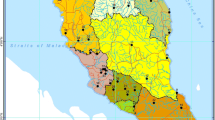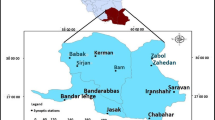Abstract
The present work studies the trends in drought in northern Algeria. This region was marked by a severe, wide-ranging and persistent drought due to its extraordinary rainfall deficit. In this study, drought classes are identified using SPI (standardized precipitation index) values. A Markovian approach is adopted to discern the probabilistic behaviour of the time series of the drought. Thus, a transition probability matrix is constructed from drought distribution maps. The trends in changes in drought types and the distribution area are analyzed. The results show that the probability of class severe/extreme drought increases considerably rising from the probability of 0.2650 in 2005 to a stable probability of 0.5756 in 2041.




Similar content being viewed by others
References
Alexandrian D, Esnault F and Calabri G 1999 Forest fires in Mediterranean area; Unasylva 50 35–41.
Cancelliere A, Mauro G D., Bonaccorso B and Rossi G 2007 Drought forecasting using the Standardized Precipitation Index; Water Resour. Manag. 21 801–819.
Caskey J E 1963 Markov chain model for the probability of precipitation occurrence in intervals of various length; Mon. Wea. Rev. 91 298–301.
Chattopadhyay S, Acharya N, Chattopadhyay G, Kiran Prasad S and Mohanty U C 2012 Markov chain model to study the occurrence of pre-monsoon thunder storms over Bhubaneswar, India; Comptes Rendus Geoscience 344 (10) 473–482.
Chin E H 1977 Modelling daily precipitation process with Markov chain; Water Resour. Res. 13 949–956.
Çinlar E 1975 Introduction to Stochastic Processes; Prentice Hall, New Jersey.
De Luis M, Ravent O S, Gonzalez-Hidalgo J, Sanchez J C and Cortina J 2000 Spatial analysis of rainfall trends in the region of Valencia (East Spain); Int. J. Climatol. 20 1451–1469.
Gabriel K R and Neumann J 1962 A Markov chain model for daily rainfall occurrence at Tel Aviv; Quart. J. Roy. Meterol. Soc. 88 90–95.
Hayes M J, Svoboda M, Wilhite D A and Vanyarkho O 1999 Monitoring the drought using the SPI; Bull. Am. Meteor. Soc. 80 429–438.
Lazri M, Ameur S, and Haddad B 2007 Analyse de Données de Précipitations par Approche Markovienne; Larhyss J. 6 7–20.
Lazri M, Ameur Z, Ameur S, Mohia Y, Brucker J M and Testud J 2013 Rainfall estimation over a Mediterranean region using a method based on various spectral parameters of SEVIRI-MSG; J. Adv. Space Res., doi: 10.1016/j.asr.2013.07.036.
Lennartsson J, Baxevani A and Chen D 2008 Modelling precipitation in Sweden using multiple step Markov chains and a composite model; J. Hydrol. 363 42–59.
McKee T B, Doesken N J and Kleist J 1993 The relationship of drought frequency and duration to time scales; In: Proceedings of the Eighth Conference on Applied Climatology, Am. Meteor. Soc. Boston, pp. 179–184.
McKee T B, Doesken N J and Kleist J 1995 Drought monitoring with multiple time scales; In: Proceedings of the Ninth Conference on Applied Climatology, Am. Meteor. Soc. Boston, pp. 233–236.
Mehrotra R and Sharma A 2005 A non-parametric non-homogeneous hidden Markov model for downscaling of multi-site daily rainfall occurrences; J. Geophys. Res. 110 D16108, doi: 10.1029/2004JD00567.
Mehrotra R, Srikanthan R and Sharma A 2006 A comparison of three stochastic multi-site precipitation occurrence generators; J. Hydrol. 331 280–292.
Moon S E, Ryoo S B and Kwon J G 1994 A Markov chain model for daily precipitation occurrence in South Korea; Int. J. Climatol. 14 1009–1016.
Moreira Elsa E, Ana A Paulo, Luís S Pereira and João T Mexia 2006 Analysis of SPI drought class transitions using loglinear models; J. Hydrol. 331 349–359.
Moreira Elsa E, Carlos A Coelho, Ana A Paulo, Luís S Pereira and João T Mexia 2008 SPI-based drought category prediction using loglinear models; J. Hydrol. 354 116–130.
Paulo Ana A and Luis S Pereira 2007 Prediction of SPI drought class transitions using Markov chains; Water Resour. Manag. 21 1813–1827.
Srikanthan R and McMahon T A 2001 Stochastic generation of annual, monthly and daily climate data: A review; Hydrol. Earth Syst. Sci. 5 (4) 653–670.
Stern R D and Coe R 1984 A model fitting analysis of daily rainfall data; J. Roy. Stat. Soc. A 147(Part 1) 1–34.
Weiss L L 1964 Sequences of wet or dry days described by a Markov chain probability model; Mon. Wea. Rev. 92 169–176.
Wilks D S 2006 Statistical Methods in the Atmospheric Sciences, 2nd edn, vol. 59, Academic Press, International Geophysics Series, 627p.
Yoo J, Kwon Hyun-Han, Tae-Woong Kim and Jae-Hyun Ahn 2012 Drought frequency analysis using cluster analysis and bivariate probability distribution; J. Hydrol. 420–421 102–111.
Author information
Authors and Affiliations
Corresponding author
Rights and permissions
About this article
Cite this article
Lazri, M., Ameur, S., Brucker, J.M. et al. Analysis of drought areas in northern Algeria using Markov chains. J Earth Syst Sci 124, 61–70 (2015). https://doi.org/10.1007/s12040-014-0500-6
Received:
Revised:
Accepted:
Published:
Issue Date:
DOI: https://doi.org/10.1007/s12040-014-0500-6




